Ingredient lists can be intimidating.
You’re in Target to pick up laundry detergent and a birthday card, but then you wander into the beauty aisles. You pick up that latest product on the shelf promising to zap your zits or iron out your wrinkles. Since you fancy yourself a sophisticated shopper, you turn over the bottle to read the ingredients. First you see “water/aqua.” “I know what that is!” you think, and now you’re cocky. But then… Propylene Glycol? Isohexadecane? Polymethylsilsesquioxane? What the heck is this stuff? You panic and turn the bottle back over. Maybe it doesn’t matter what these words mean. It advertises 37 different antioxidants and the packaging will look so chic on Instagram. Sold! Look at you, sophisticated shopper.
You can do better.
Unless you’re a chemist, you probably won’t know what these ingredients are off the top of your head and nobody expects that you will. But if you’re concerned about your products delivering on their claims, being safe for the skin, and not causing breakouts, then you need to do your homework. The good news is you have a cosmetic ingredient fairy godmother at your fingertips.
Enter CosDNA.
Meet my favorite website, CosDNA. This site will analyze the ingredients in your beauty products and rate each ingredient on its safety, its likelihood to irritate the skin, and its likelihood to cause acne. It also reports on the function of each ingredient so you can learn that the Sodium cocoyl glutamate in your cleanser is a surfactant and the Xanthan Gum is only there to control viscosity. CosDNA allows you to search for products that already exist in the database or enter your own ingredient list for analysis. Almost every product I’ve searched for has already been entered by another user.
Here’s an example report for the Sebamed Clear Face Care Gel I use:

Acne is my main concern, so the first thing I do when considering new skincare or makeup is look up the product’s acne ratings in CosDNA. You’ll notice this moisturizer has no acne-causing ingredients, which is reassuring for a product with a name like Clear Face! There’s also little chance for irritation with this product. I’ll admit I don’t read into many of the safety ratings unless they’re high (6-9). In the CosDNA rating system, the lower number the better. Acne and irritation is based on a scale of 0-5 and safety is on a scale of 1-9. Sometimes I will do further research for each ingredient on EWG’s Skin Deep Cosmetics Database. I like that each claim cites the report it came from and it also acknowledges data gaps. Once you get in the habit of looking up ingredients, you’ll start to memorize which ones you should avoid.
Ideally I would only use products with all acne ratings of 0, but that’s not always feasible. In general, I try to use products with only one or two ingredients with potential for causing acne and even then I try to keep the ratings around 1 or 2. This is much harder with makeup, so I’m not as strict there. I just try to make sure I remove my makeup as thoroughly as possible.
Do you use CosDNA? How important are the acne, irritation, and safety ratings in your routine?
